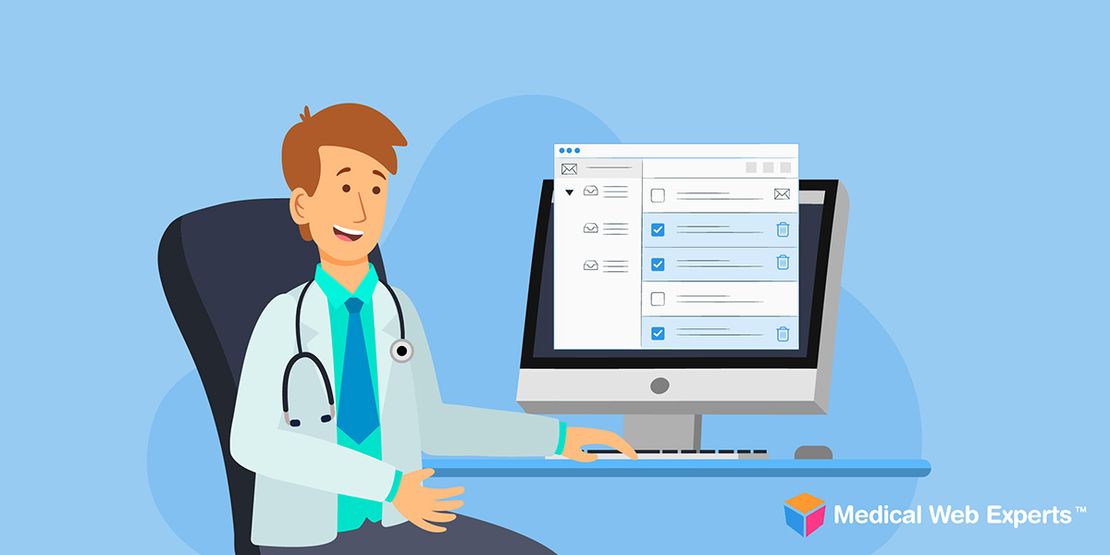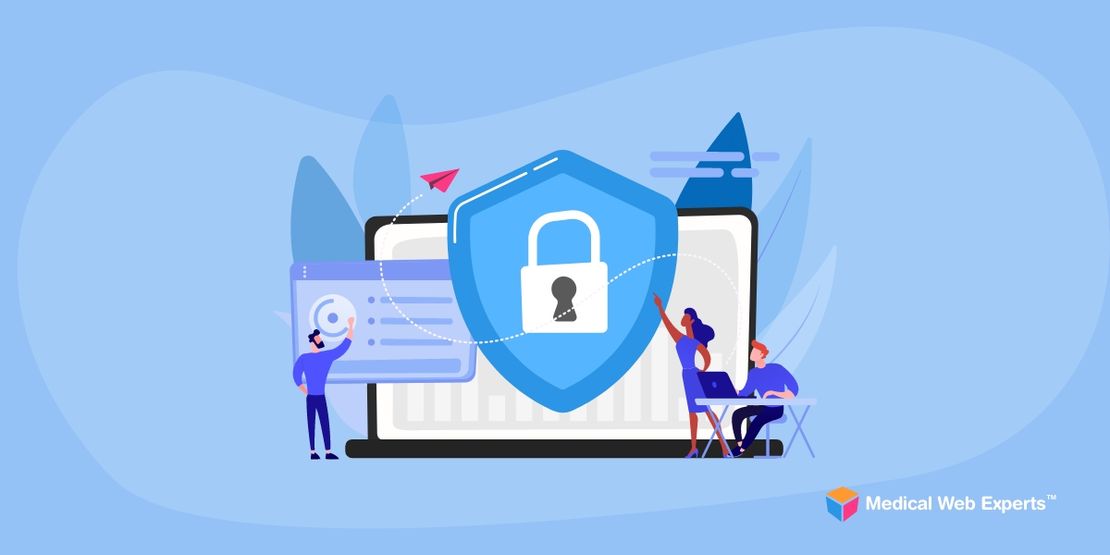Last updated: June 27, 2025
What is EMR? You might see this acronym pop up when browsing software solutions for your healthcare organization. EMR, meaning Electronic Medical Record, is essentially a digital record of patient information. EMRs play a crucial role in the modern healthcare industry, serving as central hubs of patient data, compliance, and care coordination.
Yet while commercial EMR systems are widespread, many businesses find these platforms don’t fully support unique workflows, specialized devices, or advanced patient engagement strategies. That’s where custom software development comes in—helping organizations create apps and portals that connect seamlessly with EMRs while unlocking new capabilities.
At Medical Web Experts, we help clients bridge the gap between off-the-shelf EMR software and their real-world business needs through custom healthcare app development and secure EMR integrations. Let’s explore what EMR means today, how it differs from EHR, and why custom solutions are increasingly essential for healthcare innovators.
Key Takeaways
- EMRs are essential digital hubs for patient data, but off-the-shelf systems often lack flexibility for specialized workflows, device integrations, or modern patient engagement.
- Custom healthcare software development bridges gaps in standard EMR systems, enabling tailored apps, advanced analytics, and seamless device data integration while ensuring HIPAA compliance.
- Specialized healthcare software developers like Medical Web Experts are the best way to launch secure, patient-focused digital experiences leveraging EMR/EHR integrations.
Table of Contents
- What Does EMR Mean?
- EMR vs. EHR: What’s the Difference?
- Benefits of EMR Systems
- Limitations of Off-the-Shelf EMRs
- Custom Software: Enhancing EMR Systems
- EMR Regulations
- Integrating Pre-Built Tools With Your EMR
- Conclusion
What Does EMR Mean?
An electronic medical record (EMR) is a digital version of the paper charts that have historically been used in healthcare offices. It stores data such as:
- Patient medical histories
- Diagnoses and treatment plans
- Lab and imaging results
- Medication records
- Allergy information
- Doctor’s notes
Modern EMR systems go beyond storage; they integrate with other medical software systems to support data analytics, clinical decision-making, and care coordination across providers. For example, healthcare mobile apps and patient portals often need real-time access to EMR data to display test results, enable secure messaging, or integrate device data.
EMR vs. EHR: What’s the Difference?
Many people use EMR and EHR interchangeably, but there’s a difference:
- EMR (Electronic Medical Record): A digital record of a patient’s information kept within a single provider or organization.
- EHR (Electronic Health Record): A more comprehensive record designed to be shared across multiple healthcare organizations.
The push for interoperability is making EHRs increasingly preferred over EMRs in 2025. However, EMRs still power the day-to-day data operations within clinics, hospitals, and specialty practices. According to the latest data from the CDC, 88.2% of office-based physicians are using an EMR or EHR system, with adoption expected to rise as digital transformation becomes a national priority for the healthcare industry (1).
EMR vs. EHR: Key Differences
| Feature | EMR (Electronic Medical Record) | EHR (Electronic Health Record) |
|---|---|---|
| Scope of Data | Patient data maintained within a single practice or healthcare organization. | Comprehensive patient data designed to be shared across multiple organizations and providers. |
| Primary Purpose | Internal record-keeping, charting, and treatment planning for one provider. | Enables coordinated care and data exchange across the healthcare ecosystem. |
| Data Sharing | Limited sharing outside the organization. | Built for interoperability and secure data exchange with other systems. |
| Use Cases | Small clinics, single-specialty practices, localized operations. | Hospitals, health systems, integrated care networks, population health initiatives. |
| Patient Access | May have basic patient portal features if supported. | Often integrated with patient portals and tools for patient engagement. |
| Regulatory Focus | HIPAA compliance primarily within one entity’s security perimeter. | HIPAA plus additional interoperability rules like the 21st Century Cures Act and FHIR standards. |
| Cost Considerations | Lower upfront cost; limited flexibility. | Higher initial investment; broader long-term value through interoperability. |
Benefits of EMR Systems
Whether you’re a hospital, laboratory, a device manufacturer, or another type of healthcare organization, EMRs bring significant advantages, including:
- Improved Data Accuracy: No more illegible handwriting or lost paper charts.
- Faster Information Access: Providers can retrieve records instantly, improving care efficiency.
- Data Analytics: EMRs enable population health studies, treatment effectiveness analysis, and predictive modeling.
- Patient Engagement: Data from EMRs feeds into patient portals and apps, allowing patients to manage their care.
To really get the most out of your EMR or EHR, don’t see it as a standalone solution. Rather, it’s the foundation upon which to build your entire digital front door, managing information that keeps the whole system going.
Limitations of Off-the-Shelf EMRs
Despite their strengths, an off-the-shelf EMR system, meaning one sold ready-to-use by software vendors, can be very limiting for organizations with specialized needs.
Typical pre-built EMRs often come with:
- Rigid Workflows: Many EMR systems enforce fixed processes that don’t match unique business models or device integrations.
- Limited API Support: Integrations with external apps or medical devices often require complex workarounds.
- User Experience Gaps: Patient-facing portals tied to EMRs can be clunky and generic, failing to deliver modern UX standards.
- Data Silos: Interoperability remains a challenge, even as adoption of industry standards like FHIR grows.
These create barriers to success for organizations building custom patient portals, device companion apps, or innovative care models that need specific workflows. EMR vendors usually design their products to fulfill the role of a digital charting system first and foremost, with limited functionality beyond that. Usually, it’s up to other healthcare software developers to build on that foundation and help organizations use their EMR more effectively.
Custom Software: Enhancing EMR Systems
Suppose you’re looking to incorporate or create digital healthcare tools that leverage information from an EMR. In that case, you don’t want to struggle with interoperability issues and the poor UI that usually comes with an off-the-shelf EMR system. Custom software development bridges the gap between rigid EMR systems and innovative digital health solutions, building solutions that integrate EMR into useful tools.
How Custom Development Helps
- Tailored Workflows: Apps designed for specific clinical tasks, such as fertility tracking, oncology reporting, or remote device monitoring.
- Device Integration: Real-time data sync from wearables or medical devices into the EMR.
- Improved UX: Branded portals and apps that elevate patient experience.
- Advanced Reporting: Custom analytics dashboards that leverage EMR data.
- Cutting-edge technology: AI tools that use chatbots/voice recognition to allow navigation of EMR in natural language or can make recommendations based on data analysis (2).
For example, a fertility clinic might develop a custom patient portal that integrates directly with its EMR to display cycle tracking data, appointment schedules, lab results, and an AI chatbot to field common queries. By working with an experienced healthcare software developer like Medical Web Experts, they can achieve all this, wrapped in a branded, user-friendly design.
EMR Regulations
HIPAA compliance and robust cybersecurity are critical when selecting or building an EMR because EMRs store and manage vast amounts of electronic protected health information (ePHI), including diagnoses, lab results, medications, and personal identifiers.
Regulations like HIPAA’s Security Rule demand strict controls over who can view, transmit, or modify patient data. This data is highly sensitive and a prime target for cyberattacks.
Moreover, any healthcare technology connected to EMR faces unique risks:
- EMRs often integrate with other systems, such as lab software, medical devices, or patient portals, expanding the attack surface.
- Staff may access records from various locations or devices, increasing vulnerabilities if proper safeguards aren’t in place.
A single breach can expose thousands, even millions, of patient records, leading to severe financial penalties under HIPAA and a loss of brand reputation (3).
To protect yourself from risk and liability, we recommend choosing a custom EMR vendor with experienced cybersecurity professionals on its team. Security experts with healthcare-specific expertise can help ensure:
- End-to-end encryption
- Role-based access controls
- Detailed audit logs
- Compliance with evolving security standards, like the proposed 2025 HIPAA Security Rule updates (4)
This is why choosing or developing new software that connects with your EHR isn’t just an IT decision; it’s a mission-critical move requiring expertise in healthcare workflows and regulatory compliance. If you want the highest level of compliance and functionality, contact us to explore custom development from Medical Web Experts.
Integrating Pre-Built Tools With Your EMR
Building fully custom apps isn’t the only option. Our sister company BridgeInteract provides a modular patient engagement platform for rapid deployment of:
- Secure patient portals
- HIPAA-compliant messaging
- Integration with EMR systems via APIs
- And much more
BridgeInteract can be customized to meet unique workflows while saving time and budget. It’s ideal for organizations needing flexibility without starting entirely from scratch. Learn more about BridgeInteract’s EMR integration capabilities.
Conclusion
Understanding EMR and unlocking its potential for digital solutions is crucial for any business aiming to innovate in healthcare. While off-the-shelf EMRs are powerful, they rarely fit all business models. Partnering with a team experienced in HIPAA-compliant app development and EMR integration ensures your digital health project succeeds technically while meeting compliance standards and your patient engagement goals. At Medical Web Experts, we’ve helped many organizations transform EMR limitations into competitive advantages.
Ready to realize the full potential of EMR systems? Contact us today to explore custom solutions by the experts..
Read more:
- Custom vs Off-the-Shelf Medical Software: Pros and Cons
- HIPAA-Compliant Messaging: How to Safely Share ePHI
- How To Design a HIPAA-Compliant Website
Resources:
- Centers for Disease Control and Prevention. (2024) Electronic Medical Records/Electronic Health Records (EMRs/EHRs). Available at: Link (Accessed: 27 June 2025).
- Lee, S. and Kim, S. (2021) ‘Prospect of Artificial Intelligence Based on Electronic Medical Record’, Journal of Lipid and Atherosclerosis, 10(3), p. 282. Available at: Link (Accessed: 27 June 2025).
- American Medical Association. (2025) HIPAA Violations and Enforcement. Available at: Link. (Accessed: 27 June 2025).
- US Department of Health and Human Services, Office for Civil Rights. (2025) HIPAA Security Rule to strengthen the cybersecurity of electronic protected health information, Federal Register, 6 January. Available at: Link. (Accessed: 27 June 2025).
Editor’s Note: This post was originally published in June 2011, and has been updated to reflect current policy and health IT trends.


